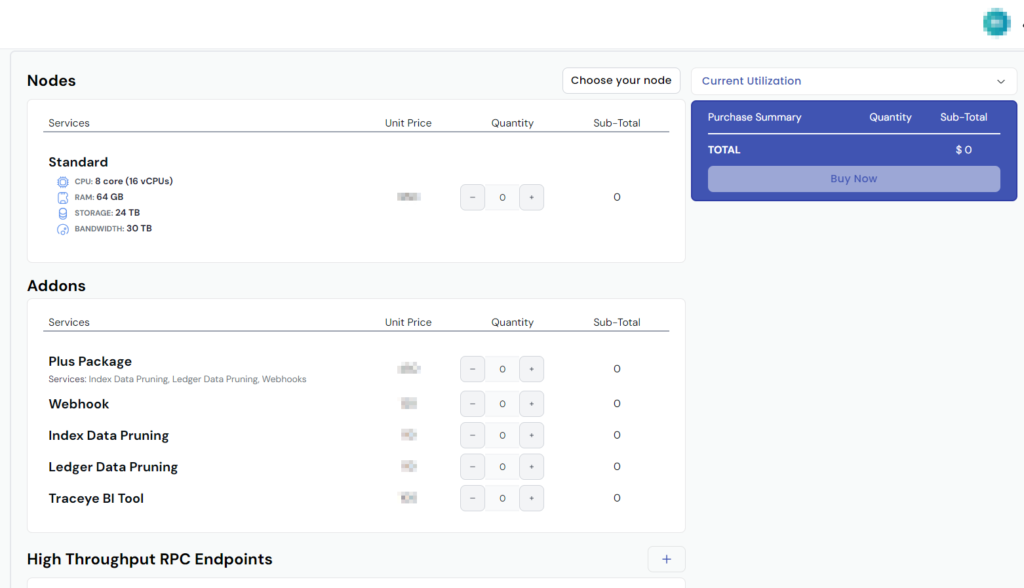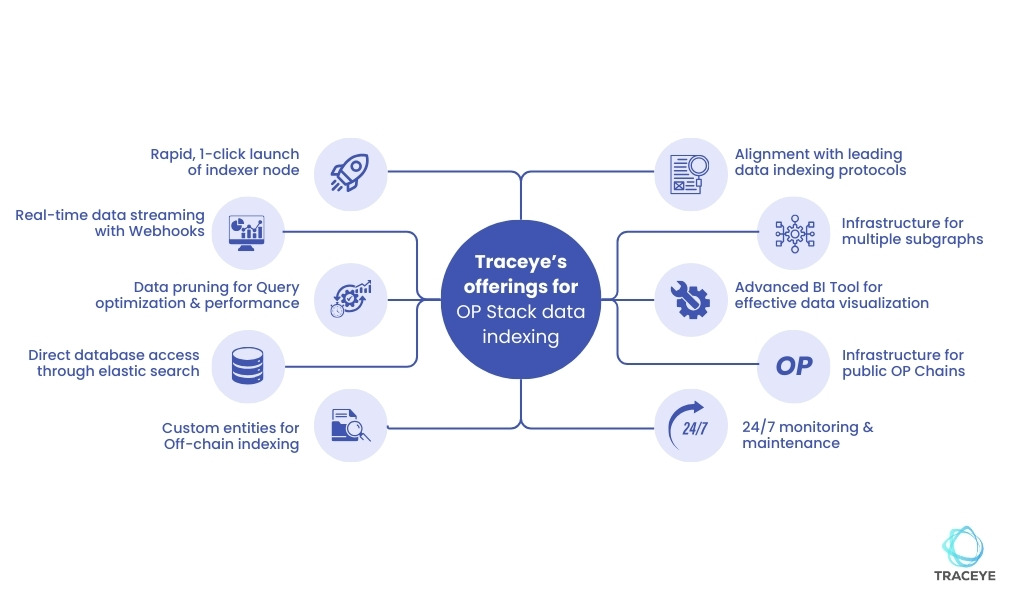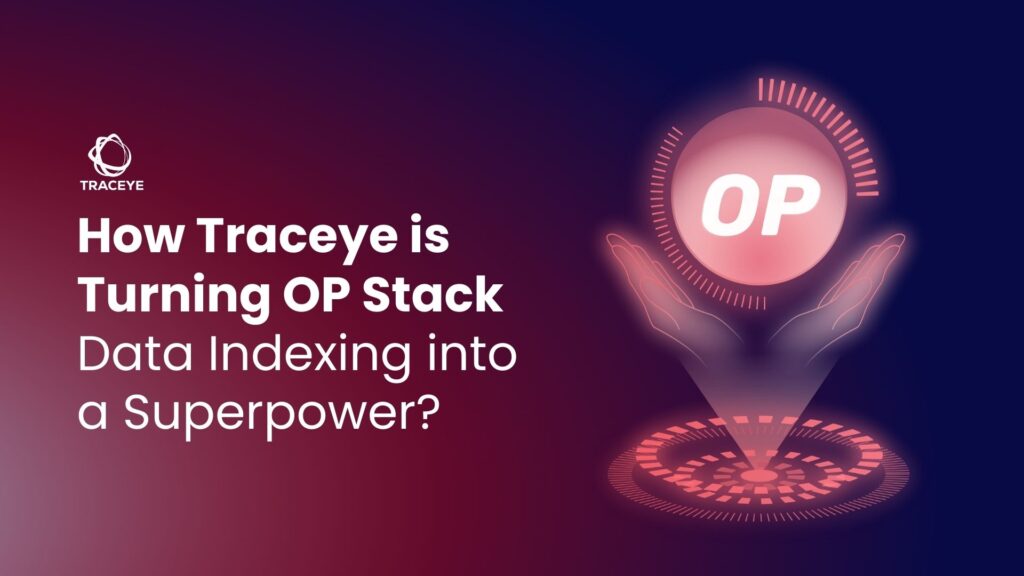Traceye has supercharged its support to facilitate high-performance data indexing for OP Stack chains. With that, Traceye now allows all types of OP chains to streamline their data indexing process while ensuring enhanced productivity, cost-effectiveness, and readiness for them.
Through this article, we will learn more about Traceye’s offerings for OP Stack data indexing to understand how it streamlines data flow for application-specific Layer2 and layer3s.
The critical role of a data indexer in OP Stack chains
Data indexers are tools that extract on-chain data, organize, and load the structured data into relevant databases for easily searchable and readable by various applications. For OP Stack chains, data indexers assist the following chains:
Permissioned OP chains: OP chains operating within a restricted ecosystem can set up a dedicated data indexer on Traceye and use it for data indexing across their specific ecosystem to index data in a fully permissionless and privacy-enabled way.
Permissionless OP chains: Public OP chains have the option to either use Traceye as their dedicated data indexer within their network or launch custom subgraphs to offer data indexing to their community. For example, a DeFi-based public OP Chain can launch DeFi subgraphs to enable real-time and indexed data for liquidity, NFT/asset ownership, tokens and more.
What makes Traceye game-changing for OP Stack data indexing?
As an advanced, feature-complete data indexing tool, Traceye allows diverse blockchains, be it Layer1, Layer2 rollups, or appchains, to launch their dedicated data indexer in just a few minutes. Projects running their data indexer with Traceye will benefit from unparalleled performance, top-notch security, unmatched scalability, and customizability. Below are the top benefits of Traceye:
- Cost reduction- With Traceye, you just need a single subscription to launch, manage, and scale your Graph node. Hence, cost will reduce significantly.
- Multiple subgraphs- As discussed, your Graph node can be used to setup multiple subgraphs and index data seamlessly from all of them.
- Ultra-fast indexing- Traceye offers 5X data fill for blazing-fast data queries and responses.
- Uptime & availability- With dedicated infrastructure monitoring and 24/7 Enterprise SLA, Traceye ensure 99.9% uptime and 50% minimized data lag, thereby maintaining uptime and availability.
- Advanced add-ons- Traceye comes with excellent, useful add-on services such as webhooks, index data pruning, ledger data pruning, and the Traceye BI tools. All these addons are available at minimal cost for both the dedicated Graph node and Hosted subgraphs.

Now. Let’s dive into Traceye’s offerings for OP Stack data indexing:
Rapid, 1-click launch of indexer node:
Traceye offers a 1-click deployment tool that OP Stack L2/L3s can use to setup and launch their dedicated data indexer/Graph node in minutes through easy steps. This low-code platform is essentially designed to eliminate the hassle of graph node using the time-taking and complex programming method. Enterprises or developers having fundamental Subgraph knowledge can launch their graph node, enable necessary add-ons, and keep track of end-to-end monitoring with Traceye’s monitoring dashboard– all on their own.
Real-time data streaming with Webhooks:
The webhook feature in Traceye allows you to access real-time data along with indexed PostgreSQL data. As we know, the need for data differs as per the application-specific requirements of OP Chains. For example, if you have a gaming OP chain, you will need hands-on access to live data about game inventory, personalization, matchmaking, or leaderboard information because these data are critical to ensure maximized player engagement. Hence, Traceye offers webhooks as an add-on feature that you can subscribe to while subscribing to the Graph node.
Data pruning for Query optimization & performance:
For data pruning, Traceye currently supports index and ledger data pruning. Both these approaches aim to optimize the database to ensure the high-geared performance of the graph node and all the subgraphs deployed on top of this. Once activated, pruning retains data for the specified block count, and it will delete older data. This way, pruning makes space for the latest data, which boosts performance significantly. Now, to understand the difference, index data pruning is designed to prune data from your network’s metadata, while ledger data pruning is done through subgraphs that use cron.
Direct database access through elastic search:
Based on the specific needs, OP Stack chains might need to query data from indexed database or they might look for direct database access. Knowing this, Traceye is now enabling direct database access through custom or elastic search. For a streamlined on-chain data streaming, you can use both GraphQL APIs or elastic search simultaneously and perform next-level data indexing.
Custom entities for Off-chain indexing:
OP Chains building often requires data from both the on-chain and off-chain sources. However, the whole process of combining Web3 and real-world data can be challenging. To provide a solution, Traceye’s custom entities allow OP Stack L2/L3s to retrieve and combine both on-chain and off-chain data to leverage for application-specific use cases. Activation for custom entities can be done easily by launching the Graph node and then adding custom entities in your preferred subgraph schema.
Alignment with leading data indexing protocols:
Traceye is 100% aligned with widely-used data indexing protocols, including The Graph Network and Subgraph Network. OP Chains interested in launching their data indexer for such popular protocols can use Traceye for 1-click node launch, seamless data indexing, management, and scaling. Speaking about blockchain networks, Traceye supports diverse blockchains which are not available on even The Graph and SubQuery protocols.
Infrastructure for multiple subgraphs:
A single Graph node that you set up on Traceye can power multiple Subgraphs launched on top of it. These subgraphs can be used for similar purposes, or they can accommodate data indexing for distinct use cases. For example, a graph node can support NFT, DeFi, general-use, or gaming subgraphs according to your OP Chain needs. Additionally, you can customize the subgraph schema’s YAML file for enhanced personalization.
Advanced BI Tool for effective data visualization:
Traceye’s BI tool is designed as an interactive & easy-to-understand data analytics tool which breaks down complex on-chain data into visual charts, graphs, and tables for enhanced visualization. As needed, you can create data charts for DeFi, Crypto, Gaming, or any relevant use cases. Likewise, you can choose the data format from graphs, pie-chart, line-chart, etc.
Infrastructure for public OP Chains:
Public OP Chains looking to build community and drive traction on their network can benefit from Traceye’s provision of offering shared infrastructure to new chains. Once added, the network will be available as shared subgraphs that data consumers can use for their data needs. This brings OP Chains a highly cost-effective and straightforward way of building community while also improving the chain’s visibility.
24/7 monitoring & maintenance:
Traceye takes responsibility for maintaining top-grade performance and availability of your Graph node and adjacent subgraphs. Traceye will keep a check on all the critical hardware & infra aspects like memory usage, CPU/RAM status, storage, and more. And, to keep you updated, Traceye offers a real-time graphical dashboard that shows this information in a readable format, such as charts and graphs.

Launch a dedicated indexer for your OP Stack Chain on Traceye
Traceye’s dedicated data indexing services are designed for all kinds of rollups and appchains, including L2/L3s built with OP Stack, Arbitrum Orbit, ZK Stack, and Polygon CDK. While the benefits of a dedicated Graph node are specific, web3 projects can still opt for the shared data indexing service for just $60 per month.
For more information about Traceye or its comprehensive services, connect with our team. Send us your queries via mail and schedule a call for detailed discussion.

Product Director & an intrapreneur with a focus on intersection of technology and business models. Having 10+ years of experience in consulting, software design & architecture, product and project management. Career track follows working on ERPs, Consumer & Enterprise products, stints in AI & Machine Learning and finally settling in decentralization & Blockchain space.
